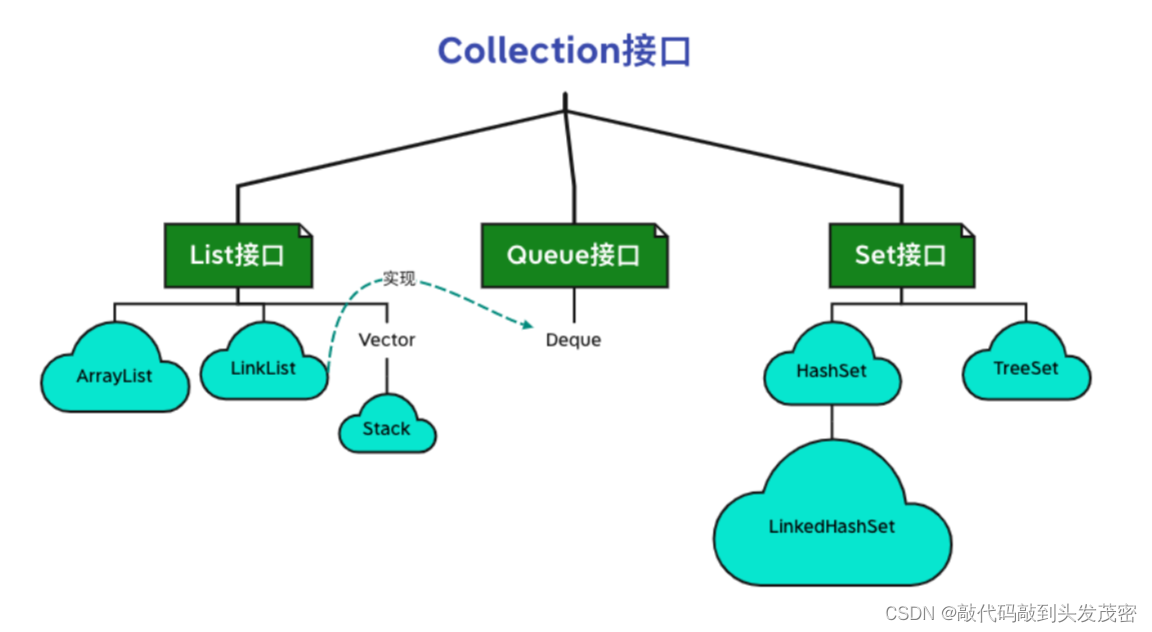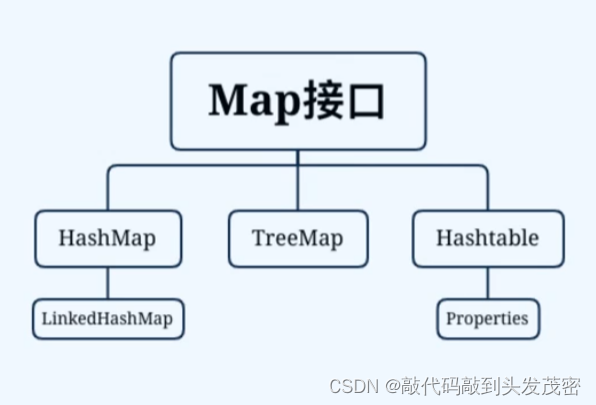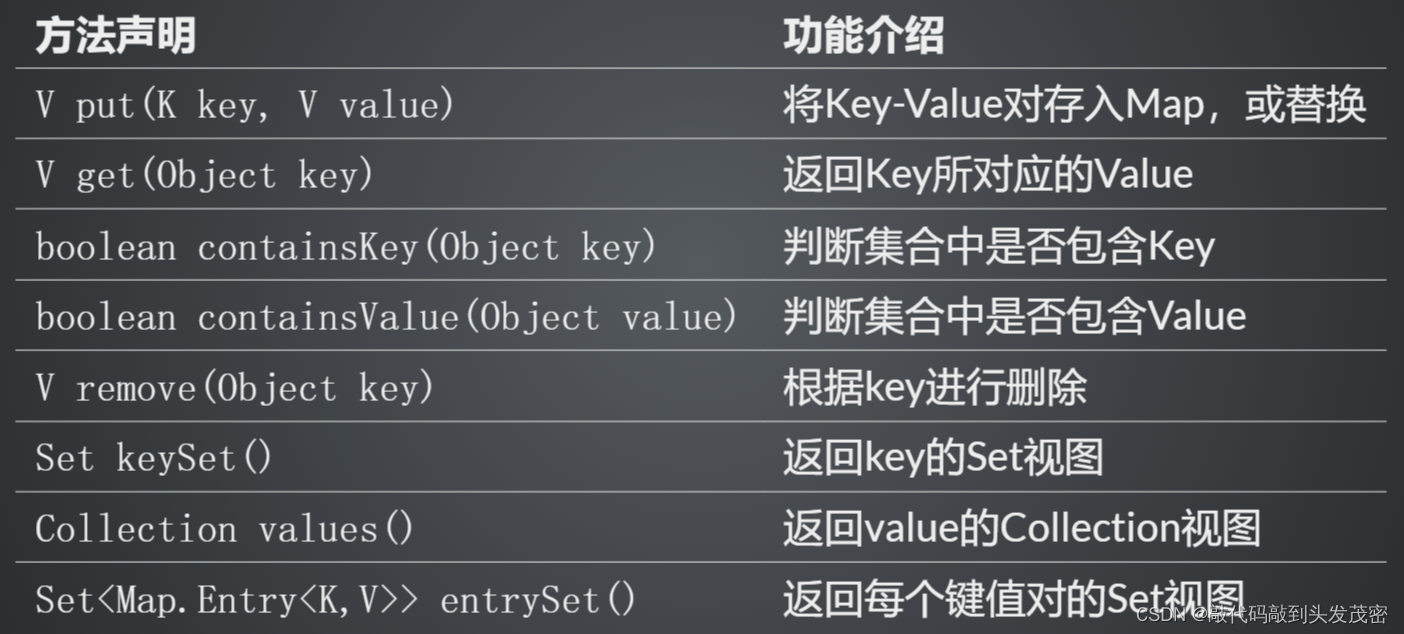本文主要是介绍Java筑基-集合[Set、Map、List、Stack、Queue],希望对大家解决编程问题提供一定的参考价值,需要的开发者们随着小编来一起学习吧!

这里写目录标题
- 一、Collection接口结构图
- 二、Set集合
- 1、常用方法
- 三、List集合
- 1、List集合常用方法
- 2、代码案例
- 四、Stack集合
- 1、方法
- 2、代码展示
- 五、Queue集合
- 1、常用的方法
- 2、代码展示
- 六、Map集合
- 1、基本概念
- 2、常用方法
- 3、代码展示
一、Collection接口结构图

二、Set集合
是Collection集合的子集合,与List集合平级
该集合中元素没有先后放入次序,且不允许重复
该集合的主要实现类是:HashSet类、 TreeSet类、LinkedHashSet类
- HashSet类采用哈希表进行数据管理
- TreeSet类采用红黑树进行数据管理
1、常用方法
准备一个Set集合指向HashSet对象,向该集合中添加元素"two"并打印,再向集合中添加元素"one"并打印,再向集合中添加元素"three"并打印,再向集合中添加"one"并打印。
package com.company.listp;
import java.util.LinkedHashSet;
import java.util.Set;
import java.util.HashSet;public class SetDemo {public static void main(String[] args) {System.out.println("------------------HashSet-----------------");Set set = new HashSet();System.out.println("set集合:"+set);boolean obj = set.add("hello");System.out.println("添加是否成功:"+obj);System.out.println("Set集合:"+set);boolean obj1=set.add("one");System.out.println("添加是否成功:"+obj1);System.out.println("Set集合:"+set);System.out.println("------------------LinkedHashSet-----------------");Set set1 = new LinkedHashSet();System.out.println("set1集合:"+set1);boolean o=set1.add("one");System.out.println("添加元素是否成功:"+o);System.out.println("set集合:"+set1);boolean o1=set1.add("two");System.out.println("添加元素是否成功:"+o1);System.out.println("set集合:"+set1);}
}set集合:[]
添加是否成功:true
Set集合:[hello]
添加是否成功:true
Set集合:[one, hello]
------------------LinkedHashSet-----------------
set1集合:[]
添加元素是否成功:true
set集合:[one]
添加元素是否成功:true
set集合:[one, two]Process finished with exit code 0三、List集合
java.util.List集合是Collection集合的子集合
List集合中允许有重复的元素并且有先后放入次序
List集合的主要实现类有:ArrayList类、LinkedList类、Stack类、Vector类。
- ArrayList类的底层是采用动态数组进行数据管理的,支持下标访问,增删元素不方便。
- LinkedList类的底层是采用双向链表进行数据管理的,访问不方便,增删元素方便。
- Stack类的底层是采用动态数组进行数据管理的,主要管理的是后进先出特征的数据结构,叫做栈
- Vector类是比ArrayList类更线程安全的类,但是效率比较低,已过时。每次扩容是2倍。
1、List集合常用方法

2、代码案例
package com.company.listp;
import java.util.ArrayList;
import java.util.List;
public class ListDemo {public static void main(String[] args) {//list集合声明List ls = new ArrayList();// 添加元素 Collectionls.add("one");ls.add("two");System.out.println(ls); //[one, two]// add(int,E)ls.add(0,"study");ls.add(1,"play");System.out.println(ls); //[study, play, one, two]// addAll()List ls1 = new ArrayList();ls1.add("qwe");ls1.add("asd");ls1.add("qwe");System.out.println(ls1); //[qwe, asd]System.out.println("------------------addAll-----------------");ls.addAll(2,ls1);System.out.println(ls); //[study, play, qwe, asd, one, two]System.out.println("------------------get-----------------");Object o=ls.get(2);System.out.println("获取下标元素:"+o); //qweSystem.out.println("------------------get重写toString-----------------");System.out.println("ls="+ls);System.out.println("ls的长度为"+ls.size());System.out.println("------------------元素出现的索引位置-----------------");System.out.println(ls.indexOf("play")); //list第一次出现的索引位置System.out.println(ls.lastIndexOf("qwe")); //list最后一次出现的索引位置System.out.println("------------------set修改指定位置元素-----------------");ls.set(4,8888);System.out.println("ls:"+ls); //ls:[study, play, qwe, asd, 8888, one, two]Integer ls5=(Integer) ls.set(4,"three");System.out.println(ls5); //8888System.out.println("修改后的ls为:"+ls); //修改后的ls为:[study, play, qwe, asd, three, one, two]System.out.println("------------------删除元素-----------------");ls.remove(ls.remove(0));System.out.println("删除后的ls为:"+ls); //删除后的ls为:[play, qwe, asd, three, one, two]System.out.println("------------------获取子集合-----------------");//获取当前集合中的子集合,将集合的一部分内容获取出来//子集合和当前集合公用一块内存空间//获取当前集合 从下标1开始到3之间的元素[1,3) 包含1不包含3System.out.println("子集合为:"+ls.subList(1,3));}
}[one, two]
[study, play, one, two]
[qwe, asd, qwe]
------------------addAll-----------------
[study, play, qwe, asd, qwe, one, two]
------------------get-----------------
获取下标元素:qwe
------------------get重写toString-----------------
ls=[study, play, qwe, asd, qwe, one, two]
ls的长度为7
------------------元素出现的索引位置-----------------
1
4
------------------set修改指定位置元素-----------------
ls:[study, play, qwe, asd, 8888, one, two]
8888
修改后的ls为:[study, play, qwe, asd, three, one, two]
------------------删除元素-----------------
删除后的ls为:[play, qwe, asd, three, one, two]
------------------获取子集合-----------------
子集合为:[qwe, asd]Process finished with exit code 0四、Stack集合
1、方法

2、代码展示
package com.company.listp;import java.util.Stack;public class StackDemo {public static void main(String[] args) {//1、准备Stack集合Stack stack=new Stack();System.out.println("stack="+stack);//2、数据11、22、33、44、55依次入栈for (int i=2;i<6;i++){Object push = stack.push(i*11);System.out.println("入栈的元素为:"+push);System.out.println("栈中的元素有:"+stack);}//查看栈顶元素并打印Object peek = stack.peek();System.out.println("栈顶元素:"+peek);//栈中所有数据依次出栈并打印int len=stack.size();for(int i=0;i<len;i++){System.out.println("出栈的元素:"+stack.pop());}//出完了之后打印,里面为空System.out.println(stack);}
}stack=[]
入栈的元素为:22
栈中的元素有:[22]
入栈的元素为:33
栈中的元素有:[22, 33]
入栈的元素为:44
栈中的元素有:[22, 33, 44]
入栈的元素为:55
栈中的元素有:[22, 33, 44, 55]
栈顶元素:55
出栈的元素:55
出栈的元素:44
出栈的元素:33
出栈的元素:22
[]Process finished with exit code 0五、Queue集合
是Collection集合的子集合,与List集合属于平级
Queue集合的主要描述先进先出特征的数据结构,叫做队列
该集合的主要实现类是LinkedList类
1、常用的方法

2、代码展示
package com.company.listp;
import java.util.Queue;
import java.util.LinkedList;
public class QueueDemo {public static void main(String[] args) {//1.Queue queue = new LinkedList();//2.元素放入队列中for (int i = 1; i < 6; i++) {boolean offer = queue.offer(i * 11);System.out.println("queue队列中元素有:" + queue);}//3.查看队列首位元素System.out.println("队列首位元素:"+ queue.peek());//11//4.队列数据出队int len = queue.size();for (int i = 1; i <= len; i++) {System.out.println("出队元素:"+ queue.poll());}//5,队列中元素System.out.println(queue);//[]}
}queue队列中元素有:[11]
queue队列中元素有:[11, 22]
queue队列中元素有:[11, 22, 33]
queue队列中元素有:[11, 22, 33, 44]
queue队列中元素有:[11, 22, 33, 44, 55]
队列首位元素:11
出队元素:11
出队元素:22
出队元素:33
出队元素:44
出队元素:55
[]Process finished with exit code 0六、Map集合
1、基本概念
Map<K,V>集合基本单位是:单对元素
K - 维护的键(Key)的类型,相当于目录
V - 映射值(Value)的类型,相当于内容
key不允许重复
一个key只能对应一个value
Map集合的主要实现类有:HashMap类、TreeMap类、LinkedHashMap类、Hashtable类、Properties类

2、常用方法

3、代码展示
package com.company.mapp;import java.util.HashMap;
import java.util.Map;
import java.util.Set;public class MapDemo {public static void main(String[] args) {Map<String, String> m1 = new HashMap<>();System.out.println("m1:" + m1); //{}//putString p = m1.put("qwe", "ert");System.out.println("p:" + p); //nullSystem.out.println("m1:" + m1); //m1:{qwe=ert}p = m1.put("asd", "zxcz");System.out.println("p:" + p); //nullSystem.out.println("m1:" + m1); //m1:{asd=zxcz, qwe=ert}System.out.println(m1.get("asd")); //zxczboolean containsKey = m1.containsKey("1");System.out.println("是否包含:" + containsKey); //是否包含:falsecontainsKey = m1.containsKey("asd");System.out.println("是否包含:" + containsKey); //是否包含:trueboolean containsValue = m1.containsValue("1");System.out.println("是否包含:" + containsValue); //是否包含:falsecontainsValue = m1.containsValue("ert");System.out.println("是否包含:" + containsValue); //是否包含:trueString s = m1.get("asd");System.out.println("获取元素:" + s); //获取元素:zxczs = m1.get("123123");System.out.println("获取元素:" + s); //获取元素:nullString r = m1.remove("asd");System.out.println("删除的value为:" + r); //删除的value为:zxczSystem.out.println("m1为:" + m1); //m1为:{qwe=ert}Set<String> keyset = m1.keySet();m1.put("ppp", "rrr");System.out.println("set集合为:" + keyset); //set集合为:[ppp, qwe]//获取键值对Set<Map.Entry<String, String>> entries = m1.entrySet();for (Map.Entry<String, String> map : entries) {System.out.println(map); //ppp=rrr qwe=ert}}
}执行结果
m1:{}
p:null
m1:{qwe=ert}
p:null
m1:{asd=zxcz, qwe=ert}
zxcz
是否包含:false
是否包含:true
是否包含:false
是否包含:true
获取元素:zxcz
获取元素:null
删除的value为:zxcz
m1为:{qwe=ert}
set集合为:[ppp, qwe]
ppp=rrr
qwe=ertProcess finished with exit code 0这篇关于Java筑基-集合[Set、Map、List、Stack、Queue]的文章就介绍到这儿,希望我们推荐的文章对编程师们有所帮助!





